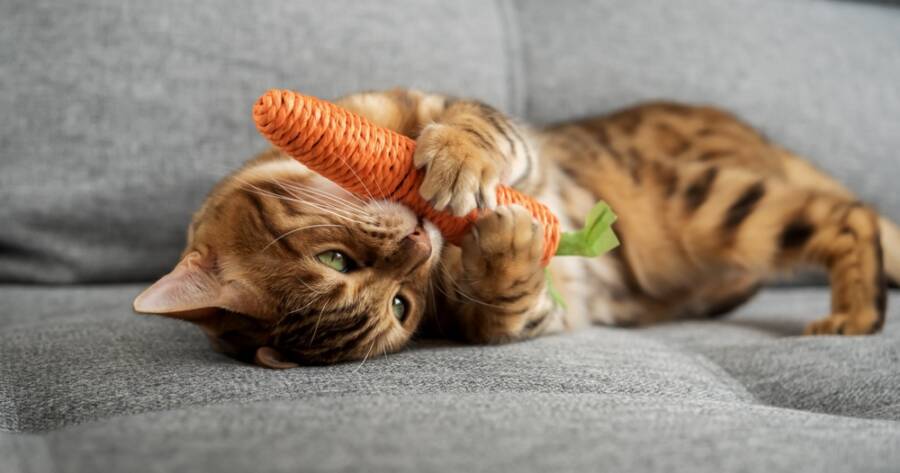A bored cat is a mischievous cat and sometimes even a depressed one. Mental stimulation is just as important as physical activity when it comes to your feline friend’s overall health and happiness. Whether your cat is a curious kitten or a laid-back senior, enrichment can help reduce stress, prevent destructive behavior, and strengthen your bond. With the right mix of creativity and consistency, you can turn everyday moments into exciting adventures for your whiskered companion.
Rotate Toys and Introduce New Challenges
Cats thrive on novelty. While they may love their favorite mouse toy today, that excitement can wear off quickly. One of the easiest ways to keep your cat mentally stimulated is by rotating toys weekly and occasionally introducing something new. This keeps your feline guessing and encourages active exploration. Puzzle toys, feather wands, and crinkle balls are all excellent additions to a rotating toy routine.
For even more engagement, try hiding a few toys around the house to mimic hunting behavior. You can also DIY enrichment items, like paper towel roll mazes or boxes with cut-out holes. The key is to offer variety—your cat will be more interested in “rediscovering” old toys when they’ve been out of sight for a while.
Create Vertical Spaces for Climbing and Perching
Cats are natural climbers and observers. Giving your cat access to vertical territory can transform their environment into a dynamic playground. Wall-mounted shelves, cat trees, and window perches offer new vantage points that mentally stimulate and satisfy their need to climb and explore. Even simple additions like stacked furniture or a safe closet shelf can add enrichment.
Perching high also gives cats a sense of security and control over their environment. If you place a perch by a window, your cat can watch birds, squirrels, and passing people, turning their downtime into a source of endless entertainment. Just be sure these climbing spaces are sturdy, accessible, and safe for all ages of cats, especially seniors or those with mobility issues.
Turn Mealtime Into a Brain Game
Feeding time doesn’t have to be routine. In fact, turning meals into an interactive experience is one of the best ways to keep your cat sharp. Puzzle feeders, slow-dispensing toys, and treat mazes encourage your cat to think, work, and engage their problem-solving skills. It adds a level of challenge to eating, which mimics the mental stimulation they’d get in the wild while hunting.
You don’t need fancy equipment, either. Hiding small portions of kibble around the house or using muffin tins as feeding stations can keep your cat busy and curious. These mealtime puzzles also help slow down fast eaters, reducing the risk of vomiting or digestive issues. Best of all, your cat learns that thinking pays off—with food!
Use Scent and Sound to Spark Curiosity
Cats experience the world through more than just sight—they rely heavily on scent and sound. Scent enrichment is a great way to pique your cat’s interest and break up a dull routine. Cat-safe herbs like catnip, valerian root, and silvervine can be rotated or hidden inside toys to encourage sniffing, rolling, and playful behavior. Even placing a blanket with a new scent can lead to a burst of exploratory activity.
Sound enrichment is another underrated tool. Try leaving the window open for natural sounds or playing soft music and bird videos made specifically for cats. Chimes, rustling paper, or even your own voice during interactive play can help stimulate their minds. Just be mindful of volume—cats are sensitive to loud or abrupt noise.
Incorporate Training and Interactive Play
Believe it or not, cats can be trained—and they love the mental engagement it provides. Teaching your cat basic commands like sit, high-five, or come using clicker training and positive reinforcement strengthens your bond and keeps their mind active. Training sessions don’t have to be long—just five minutes a day can offer huge benefits.
Interactive play is equally important. Use wand toys, laser pointers, or moving toys to simulate the hunt, tapping into their instincts. Change up your movements to keep them guessing and avoid predictability. Ending the session with a toy they can “catch” helps satisfy their hunting cycle. These moments of shared activity build trust and give your cat a physical and mental workout all in one.
Bring the Outdoors In (Safely!)
Outdoor exploration offers tons of stimulation, but it’s not always safe. Luckily, there are enriching ways to bring the outside world in. Window hammocks or “cat TV” setups give indoor cats the chance to watch birds, insects, and neighborhood activity safely from inside. Some owners also build “catios”—enclosed patios for cats—to offer safe outdoor access.
You can also collect sticks, leaves, or grass in a bag and bring them in for scent exploration. Be sure the materials are pesticide-free and pet-safe. If your cat is confident and you’re up for it, leash training can be a fantastic way to allow safe, supervised walks. Just start slow and always make sure the harness is escape-proof and comfortable.
Fostering a Happier, Healthier Cat Life
Mental enrichment isn’t just about keeping your cat busy, it’s about nurturing their instincts and helping them live a more fulfilling life. Stimulated cats tend to be happier, healthier, and more connected to their humans.
Whether it’s a simple new toy or a daily training session, small changes can have a big impact. By investing a little time and creativity, you’re giving your feline friend the gift of joy, curiosity, and well-being, one playful moment at a time.

